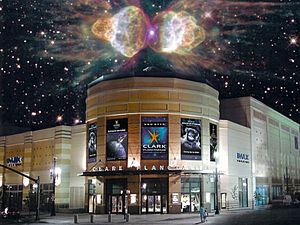Clark Planetarium facts for kids
The Clark Planetarium is a cool place where you can learn all about space and science! It's like a special planetarium and science museum located in downtown Salt Lake City, Utah, in the United States. You can find it inside a shopping and entertainment area called The Gateway. The Clark Planetarium first opened its doors in April 2003. It took the place of an older planetarium called the Hansen Planetarium. This was made possible with help from the Clark Foundation and Salt Lake County.
Contents
Explore the Clark Planetarium
The Clark Planetarium has lots of exciting things to see and do. It features two amazing theaters and many hands-on exhibits.
The Hansen Dome Theater: A Journey Through Space
The Hansen Dome Theater is a special movie theater with a huge, curved screen that looks like a giant dome.
- The dome is 55 feet (about 16.8 meters) wide. It is made of aluminum and has tiny holes.
- This theater can seat 190 people. Each seat has buttons you can use to interact with the show.
- In September 2018, the theater got new seats.
- It uses a special system called Digistar from Evans & Sutherland. Two super-clear projectors work together. They create one big video that covers the whole dome.
- You don't need special glasses to see the 3D effects!
- The system installed in 2011 shows very detailed pictures. It has a resolution of 4096 by 4096 pixels. This is much clearer than regular high-definition TV. It also shows 60 pictures every second, making movements look very smooth.
- A powerful 13,000-watt sound system is hidden behind the screen. It has 21 speakers and uses 5.1 surround sound. This makes you feel like you are right in the middle of the action!
- The shows in this theater cover many different topics about space.
The Northrop Grumman IMAX Theater: Big Screen Adventures
The Clark Planetarium also has an IMAX theater. IMAX theaters are known for their huge screens and amazing picture quality.
- The Northrop Grumman IMAX Theatre focuses on science and nature documentaries.
- You can watch both 3D and 2D films here.
- In November 2010, the theater was updated. It received new digital projectors, a new screen, new seats, and a new sound system.
Creating Shows: Behind the Scenes
The Clark Planetarium has its own team that makes digital dome movies. They use a powerful computer system called a render farm to create these films. This system has 464 connected computers working together.
Interactive Exhibits: Hands-On Science Fun
The Clark Planetarium offers 10,000 square feet (about 929 square meters) of free exhibits. You can explore many cool things without paying extra.
- One popular exhibit is "Science on a Sphere." This is a computer animation globe created by NOAA. It shows Earth's weather, oceans, and climate data in a unique way.
- Another special exhibit is "Newton's Daydream." This is a large moving sculpture made by artist George Rhoads. It uses balls and ramps to create sounds and movements.
- Other fun exhibits include a Foucault pendulum, which shows how the Earth spins.
- There's also an Earth Globe, displays of Meteorites, and different types of Telescopes.
- You can see updated videos from the Hubble Space Telescope and NASA TV.
- The Clark Planetarium is one of the few places that has a real Moon rock sample. NASA loaned this rock to the planetarium forever.
- This Moon rock came from the Apollo 15 mission. It is shown in a special exhibit about the Apollo Moon landings. You can even watch videos of the astronauts collecting this very rock!
- New exhibits are added regularly. These include a display about rockets from ATK Launch Systems, an exhibit on Solar Energy, and a display called "Weight on Other Worlds." This exhibit lets you see how much you would weigh on different planets.
Learning and Outreach: Science for Everyone
The education team at the planetarium helps many students learn about science.
- They work with over 75,000 school children each year.
- Students visit the planetarium on field trips.
- The team also travels around Utah to bring science programs to schools.
- These outreach programs include auditorium programs with exciting science demonstrations.
- They also offer in-depth visits for 6th graders, focusing on their astronomy lessons.
- Star parties are also held, giving people a chance to look at stars and other objects in space through telescopes.
- Topics covered include electricity, Newton's laws of motion, the phases of the Moon, seasons, distance and scale, planets, the Solar System, and many other interesting science subjects.
See also


